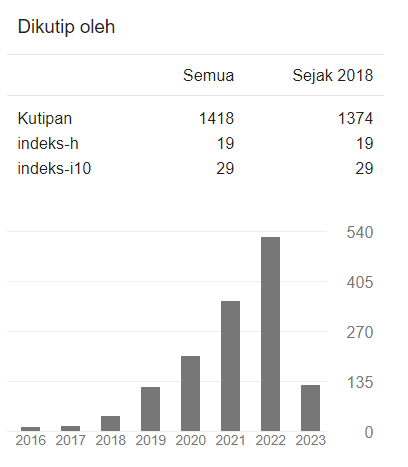Perbandingan Minat Belajar Antara Indoor Class dan Outing Class pada Siswa Sekolah Dasar
DOI:
https://doi.org/10.22219/jp2sd.v12i2.31420Keywords:
Learning Interest, , In-Class, Outing ClassAbstract
Learning interest is one of the important factors that affect the success of a student's learning; this is an essential concern that the teacher must consider. This study aimed to determine the learning interest of elementary school students in Indoor Class learning and outing class activity learning. The research method used is descriptive comparative. The population in this study was five public elementary schools in Bandung City. The sample numbered 364 students in grades 4, 5, and 6, consisting of 182 students who participated in outing class learning activities and 182 students who carried out indoor class learning. Researchers used a learning interest instrument with a reliability coefficient of 0.972 and a reliable interpretation value. Data analysis used is descriptive statistics and Independent Sample t Test test to analyze the comparison of 2 groups. The results showed that the percentage of indoor class learning was 46%, and learning in outing class activities was 54%. While analyzing the Independent Sample t-test results in Levene's Test for Equality of Variances data with a sig value. 0.000 is smaller than 0.05, so there are different variances. The Equality of Means data t-test results produce sig. (2-tailed) of 0.000 is smaller than 0.05, there is a difference, and outing class activities foster more student interest in learning. This finding is expected to be an evaluation material for related parties to build interest in learning and improve student learning outcomes.
Downloads
References
Akin, Y. (2018). Effect of Star, Acid River, and Blind Square Games in Outbound Activity to Ability Critical Thinking.
Anufia, B., & Alhamid, T. (2019). Instrumen pengumpulan data.
Bare, Y., Mansur, S., & Kurniawati, M. (2022). Persepsi Guru dan Siswa terhadap Pemanfaatan Media Pembelajaran Google Classroom pada Mata Pelajaran Biologi SMA. J Journal on Teacher Education, 3(2), 356-366.
Beames, S., Higgins, P., & Nicol, R. (2012). Learning outside the classroom: Theory and guidelines for practice: Routledge.
Bell, A. C., & Dyment, J. E. (2008). Grounds for health: the intersection of green school grounds and health‐promoting schools. J Environmental Education Research, 14(1), 77-90.
Chrisnawan, D. A., & Kamulyan, M. S. (2014). Pengaruh Pembelajaran Kontekstual Berbasis Outing Class Terhadap Pemahaman Kosa Kata Bahasa Inggris Pada Siswa Kelas III Di SD N Gajahan Karanganyar Tahun Ajaran 2013/2014. Universitas Muhammadiyah Surakarta,
Chuang, C.-Y., Robinson, J., Lin, Y.-C., Torralba, A., & Jegelka, S. (2020). Debiased contrastive learning. J Advances in neural information processing systems, 33, 8765-8775.
Darma, A., Nababan, S. A., & Alkhairi, F. (2022). Penerapan Outing Class Pada Pembelajaran Sejarah Di Madrasah Aliyah Tahfizihil Qur’an. J Keguruan, 10(1), 20-24.
Dirsa, A., BP, S. A., Diananseri, C., & Setiawan, I. (2022). Teacher role as professional educator in school environment. J International Journal of Science Education Cultural Studies, 1(1), 32-41.
Dragan, I., Dalessandri, D., Johnson, L., Tucker, A., & Walmsley, A. (2018). Impact of scientific and technological advances. J European Journal of Dental Education, 22, 17-20.
Fauziah, S. U., Qomariyah, S., Babullah, R., Rizki, N. J., & Natadireja, U. (2023). Konsep Pendidikan Holistik di Sekolah Dasar Islam Terpadu (SDIT) Assajidin Sukabumi. J Bersatu: Jurnal Pendidikan Bhinneka Tunggal Ika, 1(5), 33-44.
Fjørtoft, I. (2004). Landscape as playscape: The effects of natural environments on children's play and motor development. J Children Youth Environments, 14(2), 21-44.
Fraenkel, J. R., Wallen, N. E., & Hyun, H. H. (2022). How to design and evaluate research in education (Vol. 11): McGraw-hill New York.
Goleman, D., & Intelligence, E. (1995). Why it can matter more than IQ. J Emotional intelligence.
Istapra, E., Kusumah, R. G. T., & Walid, A. (2021). Increasing Students’ Learning Outcomes Through the Implementation of Outing Class Strategy in Natural Science Subject. Paper presented at the International Conference on Educational Sciences and Teacher Profession (ICETeP 2020).
Kamal, M. J., Haslinda, H., & Alam, A. S. (2023). Pengaruh Pembelajaran Kontekstual Berbasis Outing Class terhadap Pemahaman Kosakata Bahasa Indonesia pada Siswa Kelas V UPT SDN 27 Binamu Kabupaten Jeneponto. J Jurnal Pendidikan Tambusai, 7(2), 4408-4416.
Kerlinger, F. N. (2006). Foundations of behavioral research.
Lambert, V. A., & Lambert, C. E. (2012). Qualitative descriptive research: An acceptable design. J Pacific Rim international journal of nursing research, 16(4), 255-256.
Lele, P. B., Putra, S. H. J., Bare, Y., & Bunga, Y. N. (2023). Implementation of Outing Class to Stimulate Student Motivation. J Mattawang: Jurnal Pengabdian Masyarakat, 4(1), 1-7.
Lickona, T. (1996). Eleven principles of effective character education. J Journal of moral Education, 25(1), 93-100.
Listiana, L. (2022). MODEL PEMBELAJARAN KONTEKSTUAL BERBASIS OUTING CLASS SEBAGAI UPAYA MENINGKATKAN MOTIVASI BELAJAR TEMBANG DOLANAN (Penelitian Pada Siswa Kelas 1 di SD Negeri Petung 2, Kecamatan Pakis, Kabupaten Magelang). Skripsi, Universitas Muhammadiyah Magelang,
Manakane, S. E. (2011). Lingkungan sebagai sumber belajar dalam pengembangan konsep keruangan. J Jurnal Geografi Gea, 11(2).
Manik, W., Sagala, M. Y. S., Tampubolon, D. A., & Nababan, D. (2024). Peran Penting Sikap Disiplin Pada Anak. J WISSEN: Jurnal Ilmu Sosial dan Humaniora, 2(2), 157-166.
Muñoz-García, A. L. (2021). Outing class in the process of internationalisation. J Discourse: Studies in the Cultural Politics of Education, 42(1), 102-113.
Nasution, H. F. (2016). Instrumen penelitian dan urgensinya dalam penelitian kuantitatif. J Al-Masharif: Jurnal Ilmu Ekonomi Dan Keislaman, 4(1), 59-75.
Novanti, S. P., & Budiman, I. (2023). Analisis Tinggi Rendahnya Minat Belajar Matematika Siswa Kelas VIII di SMP Negeri 1 Anjatan. J Prosiding Sesiomadika, 4(1).
Park, T. J., Kanda, N., Dimitriadis, D., Han, K. J., Watanabe, S., & Narayanan, S. (2022). A review of speaker diarization: Recent advances with deep learning. J Computer Speech Language, 72, 101317.
Ra'o, P. Y. S., Bare, Y., & Putra, S. H. J. (2021). Pengembangan Media Teka-Teki Silang Biologi Berbasis Android Materi Sistem Gerak untuk Meningkatkan Keterampilan Berpikir Kreatif Siswa. J Jurnal Pendidikan MIPA, 11(2), 158-167.
Rahim, R., & Alam, A. S. (2023). Pengaruh Pembelajaran Kontekstual Berbasis Outing Class terhadap Pembendaharaan Kosa Kata Bahasa Indonesia pada Siswa Kelas V di SD Negeri 9 Sumanga. J Edulec: Education, Language Culture Journal, 3(2), 145-160.
Rahman, M. M., Tabash, M. I., Salamzadeh, A., Abduli, S., & Rahaman, M. S. (2022). Sampling techniques (probability) for quantitative social science researchers: a conceptual guidelines with examples. J Seeu Review, 17(1), 42-51.
Sarason, S. B. (2004). And what do you mean by learning? In: Heinemann.
Shiner, R., & Caspi, A. (2003). Personality differences in childhood and adolescence: Measurement, development, and consequences. J Journal of child psychology psychiatry, 44(1), 2-32.
Suwandi, F. P. E., Rahmaningrum, K. K., Mulyosari, E. T., Mulyantoro, P., Sari, Y. I., & Khosiyono, B. H. C. (2023). Strategi Pembelajaran Diferensiasi Konten terhadap Minat Belajar Siswa dalam Penerapan Kurikulum Merdeka. Paper presented at the Prosiding Seminar Nasional Pendidikan Dasar.
Swarjana, I. K. (2022). Populasi-sampel, teknik sampling & bias dalam penelitian: Penerbit Andi.
Syawaluddin, A., Afriani Rachman, S., & Khaerunnisa. (2020). Developing Snake Ladder Game Learning Media to Increase Students’ Interest and Learning Outcomes on Social Studies in Elementary School. J Simulation Gaming, 51(4), 432-442.
Tran, Y., Yamamoto, T., & Sato, H. (2020). The influences of environmentalism and attitude towards physical activity on mode choice: The new evidences. J Transportation research part A: policy practice, 134, 211-226.
Triana, M. N., Safari, I., & Akin, Y. (2018). Pengaruh Pembelajaran Dengan Model Bermain Terhadap Kemampuan Melempar Bola Pada Anak Tunagrahita Dalam Permainan Bocce. J SpoRTIVE, 3(1), 581-590.
Van Rossum, E. J., & Hamer, R. (2010). The meaning of learning and knowing: Brill.
Wang, Z., Zhang, Z., Lee, C.-Y., Zhang, H., Sun, R., Ren, X., . . . Pfister, T. (2022). Learning to prompt for continual learning. Paper presented at the Proceedings of the IEEE/CVF Conference on Computer Vision and Pattern Recognition.
Wright, P. M., & Craig, M. W. (2011). Tool for assessing responsibility-based education (TARE): Instrument development, content validity, and inter-rater reliability. J Measurement in Physical Education Exercise Science, 15(3), 204-219.
Yuliyanto, Y., & Fitriyati, N. R. (2019). Boosting students' interest in learning grammar by using quizlet.
Yusup, F. (2018). Uji validitas dan reliabilitas instrumen penelitian kuantitatif. J Tarbiyah: Jurnal Ilmiah Kependidikan, 7(1).
Downloads
Published
Issue
Section
License
Copyright (c) 2024 Rizki Subagja, Amung Ma'mun

This work is licensed under a Creative Commons Attribution-ShareAlike 4.0 International License.
Authors who publish with Jurnal Pemikiran dan Pengembangan Sekolah Dasar (JP2SD) agree to the following terms:
- For all articles published in Jurnal Pemikiran dan Pengembangan Sekolah Dasar (JP2SD), copyright is retained by the authors. Authors give permission to the publisher to announce the work with conditions. When the manuscript is accepted for publication, the authors agree to automatic transfer of the publishing right to the publisher.
- Authors retain copyright and grant the journal right of first publication with the work simultaneously licensed under a Creative Commons Attribution-ShareAlike 4.0 International License that allows others to share the work with an acknowledgment of the work's authorship and initial publication in this journal.
- Authors are able to enter into separate, additional contractual arrangements for the non-exclusive distribution of the journal's published version of the work (e.g., post it to an institutional repository or publish it in a book), with an acknowledgment of its initial publication in this journal.
- Authors are permitted and encouraged to post their work online (e.g., in institutional repositories or on their website) prior to and during the submission process, as it can lead to productive exchanges, as well as earlier and greater citation of published work (See The Effect of Open Access).

This work is licensed under a Creative Commons Attribution-ShareAlike 4.0 International License.


















